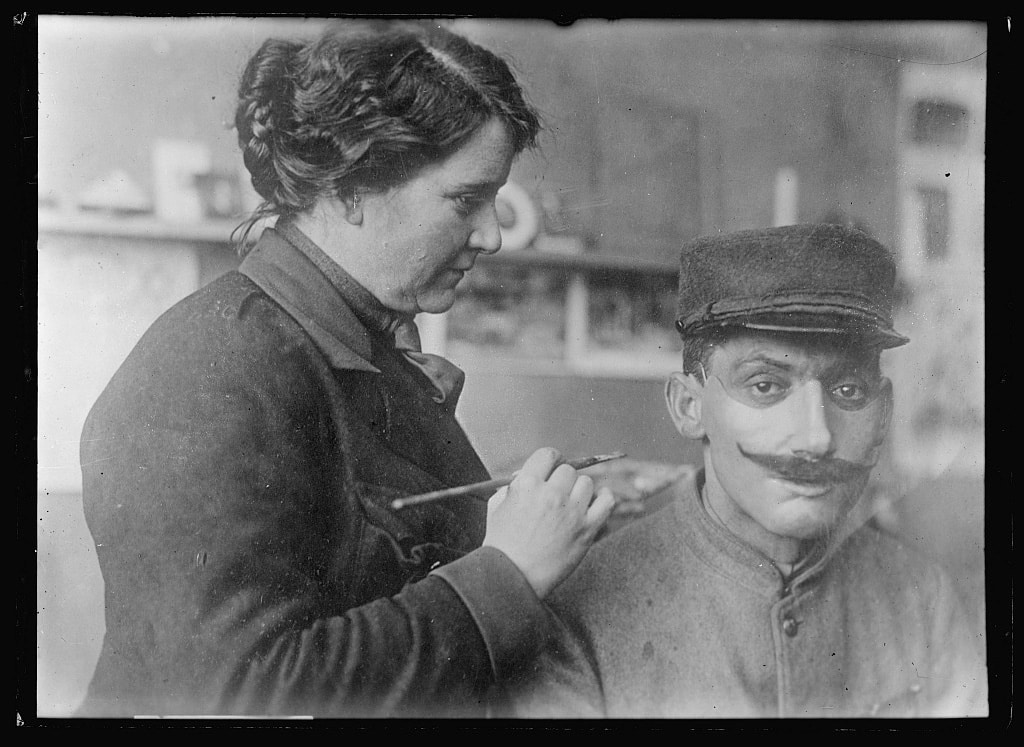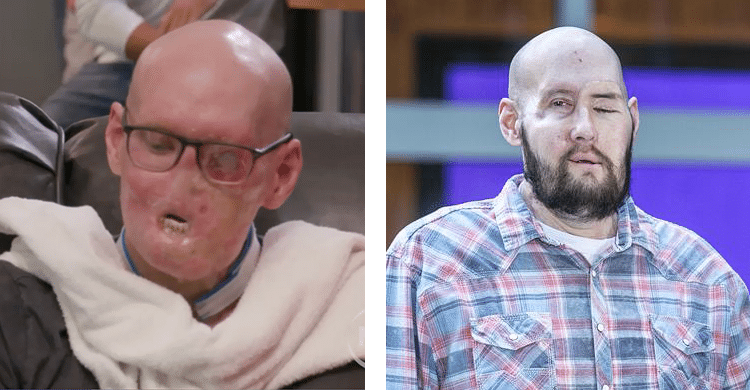Volcanoes are erupting in The Philippines, but on-fire Australia received some welcome rain. The Iran war cries have been called off and The Donald’s military powers are about to be hamstrung by the Senate. Meanwhile, his impeachment trial is starting, and we’re all on Twitter for a front-row seat.
What Could Go Right? A Century of Facial Repair
From copper masks to cutting-edge face transplants, the science of reconstructive surgery has come a long way.
This is our weekly newsletter, What Could Go Right? Sign up here to receive it in your inbox every Thursday at 5am ET. You can read past issues here.
A Century of Facial Repair
Soldiers fighting in World War I suffered ghastly injuries from trench warfare. Facial disfigurements in particular were common, as soldiers popping their heads up above the trench would be on the receiving end of a hail of gun and artillery fire.
In high demand, reconstructive surgery at that time was going through a renaissance, but it was limited and experimental—the first formal training program for plastic surgery was created soon after the war’s end, in 1924. Those with damage too severe for surgery were left with one other option. Mutilated soldiers flocked to studios in Paris and London, where they could order a hand-painted copper mask that replicated a soldier’s features pre-injury. (One hospital department in London where the masks were created was nicknamed the “Tin Noses Shop.”)

My colleague reminded me of this history last week, when a news item circulated about the welfare of Aaron James, a father from Arkansas who was employed as a high-voltage lineman. In 2021, while at work, his face accidentally came into contact with a live wire carrying 7,200 volts of electricity. He lost part of his left arm, as well as most of the left side of his face: his entire nose and lips, front teeth, cheek, and “chin down to the bone.” He was unable to eat, taste, smell, or talk normally.
In 2023, James became the first recipient of a whole-eye and partial-face transplant, in a 21-hour marathon surgery carried out by a team of 140 healthcare professionals.
One year on from the surgery, James is recovering well. He cannot see through his left eye, which the surgeons expected, since that would require the regeneration of his optic nerve. But the eye is healthy, and James’ transformation is astounding.

“I couldn’t ask for anything better,” James said in a video filmed for NYU Langone, the hospital where the surgery was performed. He can even grow his beard again.
It’s a far cry from a metal mask, and even from the very first face transplant, which was partial. The surgery was controversial when it was performed in 2005, on a French woman who had been mauled by her dog. The first whole face transplant occurred in 2010, and only about 50 have been attempted worldwide to date. Face transplant recipients must take immunosuppressants for the rest of their lives to increase the chance that their body will not reject the foreign tissue, which puts them at risk of infections and cancer.
Because they are so rare and complex, face transplants have also yet to be fully standardized as the science and standard of care develops. Comprehensive data is also scarce. A study published this month, however, showed that face transplants are generally successful, with the world’s first 50 of them generating a 10-year survival rate—of the face transplant graft itself, not the patient—of 74 percent. The five-year survival rate is higher, at 85 percent.
Ten patients of the fifty have died, many of them from post-surgery complications. That may sound grim, but these results overall are “encouraging,” the authors write, and mean that the “procedure can be seen as an effective reconstructive option for patients with severe facial defects.” It is also the only option, absent things like masks and eye patches, to mitigate the extensive psychological harm from social isolation and handicap.
New pathways in the science of face transplants are also emerging. Scientists are now testing what is called cell seeding on scaffold technology. With this, a patient’s cells can be grown on a scaffold of extracellular matrix—the material between cells—to produce functional organs. Recently, steps have been taken toward obtaining facial scaffolds from human cadavers.
The customers of the Tin Noses Shop would be impressed.
What Could Go Right? S6 E22

What are the effects of having so much technology at our fingertips? Are we connected to too much information at once? Is technology shortening our attention spans? Zachary and Emma speak with Gloria Mark, psychologist and author of Attention Span: A Groundbreaking Way to Restore Balance, Happiness and Productivity. They discuss the decrease of attention span over the years, ways to read and listen without distraction, and the emotional residue left by social media. | Listen now
By the Numbers
754,303: The number of electric cars in Norway, versus the 753,905 gas-powered ones. Electric cars just outnumbered gas cars in the Nordic country for the first time.
96: The percentage of American corporations that offer maternity leave, up from about half of companies a decade ago. Ninety-three percent offer paternity leave. (Many other facts and figures from a recent report about gender inclusivity in the workplace here.)
26: The number of states that have passed or are considering passing bills that regulate AI-generated content in relation to elections.
Quick Hits
🏭 Are China’s carbon emissions peaking? Have they already peaked? It’s too early to tell for sure, but climate experts are discussing whether China’s recent emissions decline is temporary or the beginning of a long-term trend. Either way, the nation would still need to get to net-zero.
👃 The United States has approved the first at-home flu vaccine, a nasal spray produced by the pharmaceutical company AstraZeneca. It will be available in the fall of 2025 and is suitable for adults under 50 and children older than 2.
🦠 Jordan has become the first country in the world to officially eliminate leprosy, a neglected tropical disease that results in 200,000 cases annually worldwide.
🕵️ Japanese scientists have used artificial intelligence to discover 303 new “geoglyphs,” images cut into the desert floor, made by a pre-Inca civilization in Peru.
✂️ The Federal Reserve has cut interest rates by a half percentage point, and more cuts are expected in the coming months, leading to lower rates on mortgage loans, credit cards, and much besides.
🏳️🌈 Kentucky’s governor has used his executive powers to ban conversion therapy, which attempts to change a person’s gender or sexual orientation, on minors in the state.
🚫 England and Wales are rolling out “buffer zones” outside of abortion clinics, which will prevent protesters from standing within 150 meters of them. From October 31, it will also be against the law to “influence, harass, or provoke those using or delivering pregnancy termination services.”
🦏 Rhino poaching has dropped 80 percent in one of South Africa’s national parks, where a dehorning program was put into place in April. Nigeria has just unveiled its first national protection program for its endangered elephants.
🛰️ Google will begin flagging AI-generated images in Search later this year (with caveats), and is also deploying satellites into low-Earth orbit to detect and track wildfires anywhere on the planet. Instagram is introducing various changes for teen accounts ($), such as making them private by default and silencing notifications between 10pm and 7am.
🪪 Americans can now renew their passports online! Some exceptions apply.
🧬 Updates: In December of last year, we reported that the first two gene therapies for treating sickle cell disease had been approved for use in the US. The first patients have begun receiving it, but its rollout has been marred by obstacles, including its price tag and other logistics. (NYT $)
Our newsletter last week highlighted the reduced rates of domestic violence in the US since the 1990s. Globally, the landscape of legal protections has changed as well. Until the 90s, less than 1 percent of the world population was legally protected from domestic violence. Now 9 in 10 people are.
💡 Editor’s pick: No central database exists for collating evidence-based solutions for major social problems. So when governments go to make policy, they aren’t sure what actually works. Now, tens of millions are being funneled into an effort to create one.
TPN Member Originals
(Who are our Members? Get to know them.)
- America’s role in the world is hard. It just got much harder. | NYT ($) | Thomas L. Friedman
- An extraordinary month is unfolding in the international movement to roll back the phone-based childhood | After Babel | Jonathan Haidt
- Forget fusion voting, look to Alaska! | Boston Review | Danielle Allen
- The new report on the Supreme Court | Tangle | Isaac Saul
- When climate anxiety leads to childlessness | Faster, Please! | James Pethokoukis
- How to speak truth without fear | The Atlantic ($) | Arthur C. Brooks
- Authoritarianism and hatred are no match for a politics of love | LA Times | Ruth Ben-Ghiat
- How to choose what to work on | The Roots of Progress | Jason Crawford
- AI and our conspiracy theorist overlords | Nonzero | Robert Wright
- Bye bye inflation. We hardly knew you . . . | The Edgy Optimist | Zachary Karabell
- Trump’s tax plans mean higher mortgage interest rates | Slow Boring | Matthew Yglesias


